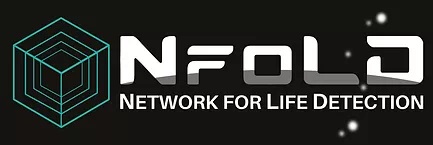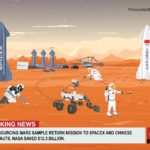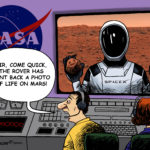Cite as: Benner, S. A. (2022) “Is ignorance bliss? NASA’s NfoLD Workshop”. Primordial Scoop, e20220403. https://doi.org/10.52400/TMUG1175
One approach to find new ways to solve an old problem begins by throwing the experts out of the room. One then asks a bunch of non-experts to talk through the problem from scratch.
The idea is simple enough. The experts, one fears, will simply re-state their past positions, re-ignite old fights, and re-advocate their own old ideas. The non-experts will not be so constrained. They will see the problem afresh, and come up with solutions that are truly new.
Or, at least, that’s the idea.
Albert Einstein may be seen as an archetype of this approach. As someone who “read little, but thought much”, Einstein likely did not know that some of his equations had already been put into the literature by Fitzgerald and other contemporaries. After all, the problems with Maxwell’s equations describing the propagation of electromagnetic waves were recognized almost immediately after those equations appeared, in the 1860s.
However, none of the established experts in physics before Einstein understood the impact of their equations on basic concepts in physics, like “simultaneity”. That needed a patent examiner, isolated from the main streams of thought among the professionals of the day.
An examiner who time to think, free from the rat race of the Academy. As Einstein himself later remarked, he doubted that he would have come up with his 1905 papers had he been a professor. Too many committee meetings.
NASA’s NfoLD workshop appears to have adopted this “ignorance is good” approach. As did last year’s NfoLD committee to define “standards” by which claims for life were to be evaluated. As many have now commented, on this blog and elsewhere, the “Standards” Report showed few signs of expert input covering past efforts to seek non-terran life, including those done by NASA.
So how is NfoLD doing so far?
Unfortunately, the Workshop is showing the problems of being ignorant.
One intrinsic weakness of the approach arises because total ignorance cannot be a starting point. Einstein had to know at least something about Maxwell’s equations. Bringing true ignoramuses into a room to discuss an important problem in science or technology ends up with discussions of Mayan calendars, alien abductions, homeopathy, or worse.
Further, even non-experts are rarely isolated from expert opinions. Einstein worked without the internet. Today’s student, hardly. They have heard words, buzz and others, in their cultural environment. Thus, a very real problem in the “ignorance is useful” approach is that the bad parts of the past may survive as catch-phrase half-ideas, filtering into “uncontaminated-by-expertise” thinking, without the expertise to understand why past ideas might have been bad ideas.
Further, NASA does not follow Einstein’s advice about committee meetings. NASA loves confabs.
I did a back of the envelope estimate of the hours (over 4000) I have spent in NASA committee meetings since, a quarter century ago, I noted at a meeting at JPL (experts Steve Squyres and Charles Elachi were in the room), that (i) The Viking gas chromatograph-mass spectrometer data had been misinterpreted, (ii) the Martian surface is not self-sterilizing, (iii) the Martian soil contained abundant organics, so (iv) NASA should get serious about seeking extant non-Terran life.
So what can we say about the Workshop work product?
First, the amount of time, in people-hours, devoted to this workshop is painful to contemplate.
Added to this, the presenters had just 120 seconds to report the outcome of hours of time pondering what is arguably NASA’s most important science question.
Screenshots of the rapidly changes slides uncover some jewels. More on these in a later post. A few actually got mentioned to the group at large, but only by accident.
For example, one of the Mars teams was cut off before they got to the interesting part of their talk, their third slide. Fortunately, we learned about the third slide because the question-and-answer times were basically dead. The silence gave one of the Mars-presenting colleagues the opportunity to ask the colleague presenter about … the third slide. So we learned that catalysis of hydrolysis may be a biosignature.
But the conformity of group-think was evident. Group after group had slide after slide with the same words repeated over and over, selected from a small set of words that predated the turn-of-the-century in the field of life detection.
Most groups suggested “chirality” as a biosignature. Most looked for amino acid, lipids, and nucleotides, even on Titan, where the constraints on solubility in cryogenic methane were overlooked. Most looked for elemental abundances in constrained spaces. And so on.
All of these words were in the lexicon of life detection strategies from the 1970s, and clearly had filtered into the culture. Thus, using non-experts to rethink the problem failed to generate broadly new ideas. Also missing was the expertise to know why many of these are bad biosignatures, at least if naïvely applied. More in a later post.
Of course, some experts were present. One of them eventually had had enough.
Mary Voytek, the chief NASA astrobiology expert, likely intended to remain silent to see what the group produced. However, with report after report saying that they had decided to look for microbial motility as a sign of life, Mary broke in, with her expertise.
And that expertise? When nutrients are scarce, microbes are not motile. In a resource poor environment, it is bad to use resources to move to look for “the food truck”. The winning adaptive strategy is to stay non-motile waiting for the food truck to come to you.
Mary took 120 seconds to make that point.
This intrusion of expertise prevented further mentions of motility. Good? Well, when one is generating ideas, bad. Good would have been some following back-and-forth on the area, where people challenged the expert opinion, the expert responded, and an argument ensued. True diversity.
The exploration of the cosmos is a trans-generational undertaking. Each generation has a cultural inheritance that, if taught correctly, lets the next generation not make the same mistakes that were made before, without constraining imagination, diversity, and novelty.
That cultural inheritance is not obviously being retained by NASA’s instruction of the next generation of astrobiology. And that is bad.



